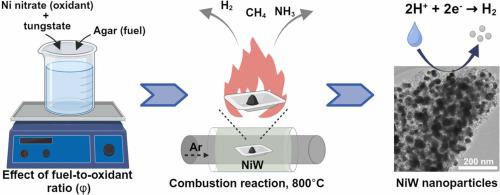当前位置:
X-MOL 学术
›
Nano-Struct. Nano-Objects
›
论文详情
Our official English website, www.x-mol.net, welcomes your feedback! (Note: you will need to create a separate account there.)
Solution combustion synthesis of nanostructured Ni/W-containing electrocatalysts for hydrogen evolution reaction: The effect of fuel-to-oxidant ratio
Nano-Structures & Nano-Objects Pub Date : 2023-11-24 , DOI: 10.1016/j.nanoso.2023.101075 Kanghoon Choi , Sasha Omanovic
Nano-Structures & Nano-Objects Pub Date : 2023-11-24 , DOI: 10.1016/j.nanoso.2023.101075 Kanghoon Choi , Sasha Omanovic

|
The effect of varying fuel-to-oxidant ratio (φ) on the physicochemical properties and electrocatalytic performance for the hydrogen evolution reaction (HER) of nanostructured NiW materials produced via solution combustion synthesis (SCS) method was investigated. Agar and nickel nitrate served as the fuel and oxidant, respectively. TGA-MS results revealed that a fuel-to-oxidant ratio of 9 (φ9) provides the optimal conditions for reducing metal oxides to metallic phases due to the highest emission of reducing gas species (H, CH, and NH). N adsorption/desorption measurements indicated that under fuel-rich conditions (φ > 1), both the specific surface area and porosity expanded with increasing the fuel quantity. Microscopy characterization was found to be consistent with N adsorption/desorption and TGA-MS results, revealing that the increased gas expulsion from higher fuel content led to more pronounced coral-like structures comprising of nano-sized particles and pores. Evaluation of electrocatalytic activity in an acidic medium (0.5 M HSO) revealed that the φ9 sample demonstrated the highest electrocatalytic HER performance. XRD and XPS analyses correlated well with this result, attributing the enhanced HER activity to the presence of the NiW metallic phase, limited oxide formation, and the highest proportions of metallic Ni and W atomic states, beyond mere surface area effects. Consequently, this study provides valuable insights into the importance of the fuel-to-oxidant ratio in optimizing the SCS method for controlled synthesis of nanostructured NiW materials in terms of morphology and composition, with implications for their potential development as high-performance, cost-effective electrocatalysts.
中文翻译:

溶液燃烧合成纳米结构 Ni/W 电催化剂用于析氢反应:燃料与氧化剂比例的影响
研究了不同的燃料与氧化剂比(φ)对通过溶液燃烧合成(SCS)方法生产的纳米结构NiW材料的析氢反应(HER)的物理化学性质和电催化性能的影响。琼脂和硝酸镍分别充当燃料和氧化剂。TGA-MS 结果表明,由于还原性气体物质(H、CH 和 NH)的排放量最高,燃料与氧化剂的比率为 9 (φ9),为将金属氧化物还原为金属相提供了最佳条件。N吸附/解吸测量表明,在富燃料条件下(φ > 1),比表面积和孔隙率都随着燃料量的增加而扩大。显微镜表征被发现与 N 吸附/解吸和 TGA-MS 结果一致,表明较高燃料含量导致气体排出量增加,导致由纳米尺寸颗粒和孔隙组成的更明显的珊瑚状结构。在酸性介质(0.5 M HSO)中的电催化活性评估表明,φ9 样品表现出最高的电催化 HER 性能。XRD 和 XPS 分析与这一结果很好地相关,将 HER 活性的增强归因于 NiW 金属相的存在、有限的氧化物形成以及金属 Ni 和 W 原子态的最高比例,而不仅仅是表面积效应。因此,这项研究提供了关于燃料与氧化剂比率在优化 SCS 方法中的重要性的宝贵见解,以控制合成纳米结构 NiW 材料的形态和成分,并对其作为高性能、成本低廉的潜在发展具有影响。有效的电催化剂。
更新日期:2023-11-24
中文翻译:

溶液燃烧合成纳米结构 Ni/W 电催化剂用于析氢反应:燃料与氧化剂比例的影响
研究了不同的燃料与氧化剂比(φ)对通过溶液燃烧合成(SCS)方法生产的纳米结构NiW材料的析氢反应(HER)的物理化学性质和电催化性能的影响。琼脂和硝酸镍分别充当燃料和氧化剂。TGA-MS 结果表明,由于还原性气体物质(H、CH 和 NH)的排放量最高,燃料与氧化剂的比率为 9 (φ9),为将金属氧化物还原为金属相提供了最佳条件。N吸附/解吸测量表明,在富燃料条件下(φ > 1),比表面积和孔隙率都随着燃料量的增加而扩大。显微镜表征被发现与 N 吸附/解吸和 TGA-MS 结果一致,表明较高燃料含量导致气体排出量增加,导致由纳米尺寸颗粒和孔隙组成的更明显的珊瑚状结构。在酸性介质(0.5 M HSO)中的电催化活性评估表明,φ9 样品表现出最高的电催化 HER 性能。XRD 和 XPS 分析与这一结果很好地相关,将 HER 活性的增强归因于 NiW 金属相的存在、有限的氧化物形成以及金属 Ni 和 W 原子态的最高比例,而不仅仅是表面积效应。因此,这项研究提供了关于燃料与氧化剂比率在优化 SCS 方法中的重要性的宝贵见解,以控制合成纳米结构 NiW 材料的形态和成分,并对其作为高性能、成本低廉的潜在发展具有影响。有效的电催化剂。



























 京公网安备 11010802027423号
京公网安备 11010802027423号